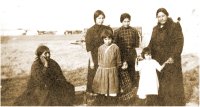Historic Dakota
Most
of the people listed below were involved in the Minnesota Conflict,
which started at the Lower Sioux Agency in August 1862. It lasted
less than six weeks and in that time many people were displaced from
their homes. For their crime of fighting for survival 38 Dakota men
were hung on December 26th 1862 in Mankato, Minnesota. Two others,
Shakopee and Medicine Bottle were hung there later. Little Crow was
shot by a farmer while collecting berries in a field, and his body
was put on show for many years, eventually being buried in Flandreau
100 years later. The Dakota were taken to Fort Snelling and then transported
to places such as Crow Creek, which was a desolate area compared to
the area along the Minnesota River.
There
are today various areas where the Santee Dakota reside, Pipestone
is just one place. The closest to Pipestone is Flandreau in South
Dakota, and the Lower Sioux and Upper Sioux Reservations in Minnesota.


Little
Crow (Mdewakanton)
War Chief of the Dakota bands at the time of the 1862 Conflict. He
left and went to Canada for safety but returned and was killed by
a farmer in a field. Eventually his remains were buried with ceremony
in Flandreau by his family over a hundred years later. Today people
still leave offerings at his grave that is marked by a staff and a
stone fit for a Chief after all those years.


Wabasha (Mdewakanton)
Hereditary Chief of his band at the time of the 1862 Conflict, he
was sent to Santee Nebraska in 1862, and stayed there with many of
his band. His descendant Ernie Wabasha is the latest hereditary Chief
of the Mdewakanton at the Lower Sioux. He also has two other descendents
living in Santee. Wabasha is buried in a small cemetary in Santee.
His grave is hardly noticable except for the staff that has been placed
next to the small granite block with his name engraved in it.
Shakopee (Mdewakanton)
A Chief at the time of the 1862 Conflict. He was hung in 1863 along
with Medicine Bottle (Big Eagle's brother), after they had been captured,
drugged and brought back to Minnesota from Canada, in complete disregard
for international law.
Black Dog
(Mdewakanton)


Mankato
(Mdewakanton)
War Chief of the Mdewakantons during the 1862 Conflict. He was killed
at the Battle of Wood Lake.
Travelling
Hail (Mdewakanton)
He had been elected as Chief of the Mdewakanton's in place of Little
Crow prior to the Conflict, and although he was a Chief of his band
the people chose Little Crow to lead them during the Conflict. Travelling
Hail had gone to Washington in 1858 with a group of Chiefs, (including
Little Crow, Mankato and Big Eagle) to sign a Treaty with the President,
he was a well respected man. The treaty the Chiefs signed was soon
broken.


Big Eagle (Mdewakanton)
Sub-chief at the time of the 1862 Conflict. He wrote his views of
the Conflict in the early 1900's. He was one
of the founders of the Flandreau reservation. He moved between Minnesota
and South Dakota quite a few times after he was released from the
Davenport prison he was sent to for two years for his part in the
Conflict. Owning a farm close to Brookings, SD for many years, he
eventually went back to his homeland in Minnesota and is buried at
the Upper Sioux, (Doncaster cemetary) his grave is marked by a small
white obelisk giving his name Wamditanka, the date of his death and
a small prayer in Dakota. The marker is crumbling as are many from
that era.
Scarlet
Plume (Sisseton-Wahpeton)
Red Iron
(Sisseton-Wahpeton)
John Otherday
(Sisseton-Wahpeton)
Was a friend to many white settlers at the time of the Conflict, and
was given a reward for saving so many lives by the government. He
was also allowed to stay in Minnesota when most other Dakota were
forced out.
Paul Mazakutemani
(Sisseton-Wahpeton)
Also a friendly to the settlers, helped many escape from the area.
He stated to Little Crow, "Stop fighting. No one who fights with
the white people ever become rich, or remains two days in one place,
but he is always fleeing and starving."
Red
Legs (Wahpekute)

Our Family
 |
This
is a photo of our ancestors in the early 1900's. When
she was a small child, the lady on the left, (Grandma Amos)
was in Pipestone with her family in the summer of 1862. The
came each year to quarry for the stone and would then take it
back to make Pipes for the tribe to use. As they were on their
way home they saw smoke on the horizon, and wondered what it
was. When they got closer they found it was houses burning and
the Dakota - US Conflict of 1862 had started. They left Minnesota
at that point for a few years and went up to Canada. Returning
to their homeland (Upper Sioux Agency area) once it was safe
to do so.
|
 |
A
more formal photograph of the family, the child in the front
center is Estella Pearsall who married Moses Crow and moved
to Pipestone in 1927. She and Moses met at the Pipestone Indian
School when they were children, eventually running away from
there to get married. They returned to Pipestone years later
after Moses had found work at the school, soon after leaving
the military.
|







